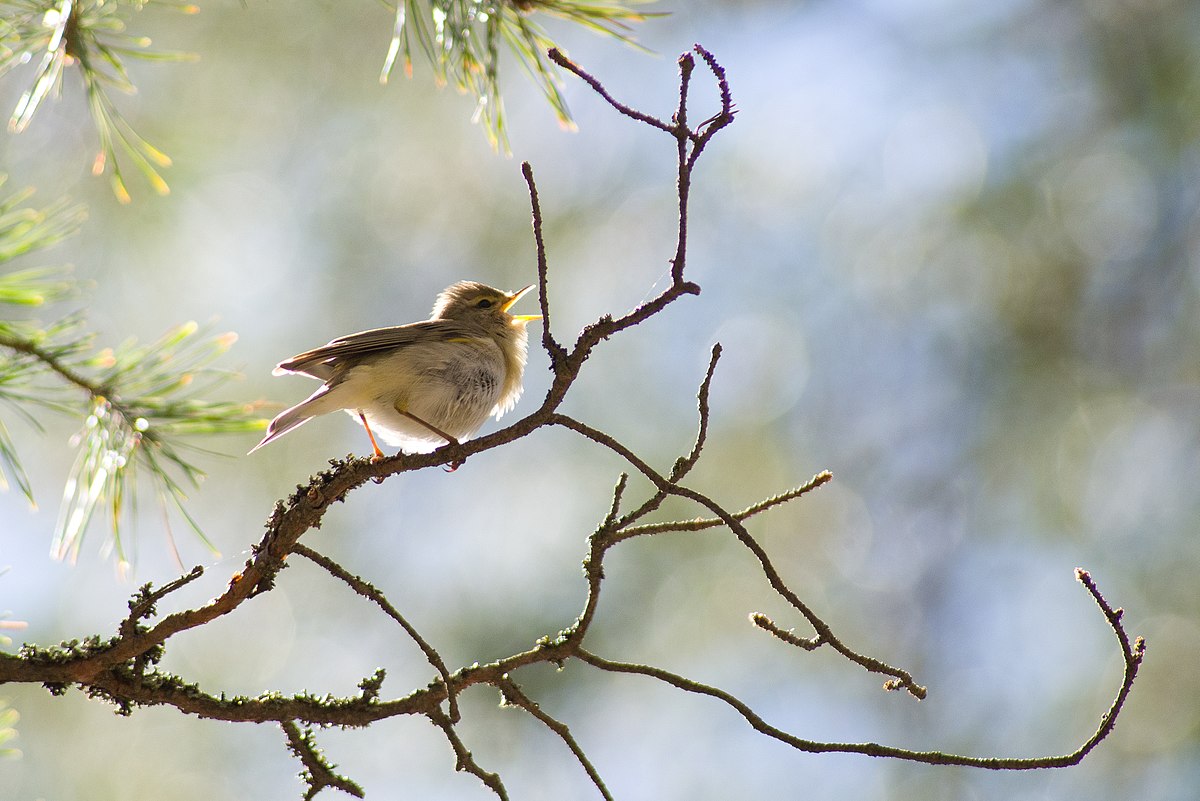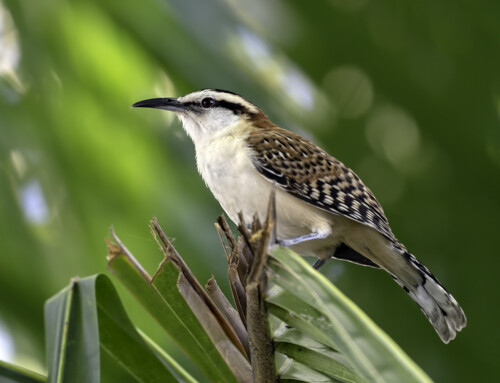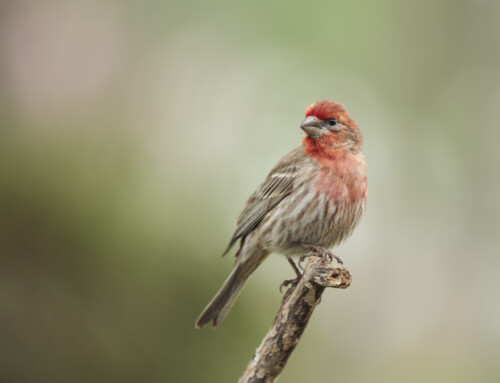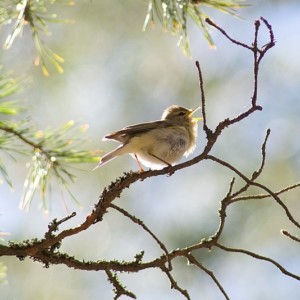 LINKED PAPER
LINKED PAPER
Bird population declines and species turnover are changing the acoustic properties of spring soundscapes. Morrison, C.A., Auniņš, A., Benkő, Z. et al. 2021 Nature Communications. doi: 10.1038/s41467-021-26488-1 VIEW
For many ornithologists, one of the first signs of spring are the songs of familiar species returning to their favourite patches. For myself, having worked with migratory warblers for many years, the first time I hear the repetitive ‘chiffchaff’ of the onomatopoeically named species and, later, the cascading song of Willow Warblers (Phylloscopus trochilus), I feel a rush of excitement in the knowledge that nature is starting to spring into action once again.
Across our BOU community, such signs may be as diverse as the places in which we live and if we could time travel back ten or twenty years; the species which form the soundtracks of our spring may have been different again, changing in parallel with our environments. Perhaps the one constant is the importance that they play in our lives, deepening our connection with nature and our surroundings. Understanding the extent of shifts in spring soundscapes and how they have been influenced by the changes in bird abundance and species diversity is the focus of our latest research.
Recreating historical soundscapes
Across North America and Europe, standardised annual counts of breeding birds are carried out by volunteer ornithologists. In North America, surveys of breeding bird numbers take place under the North American Breeding Bird Survey (NA-BBS), while in Europe, similar data are collated by the Pan-European Common Bird Survey (PECBMS). While these historical data to tell us about changes in species diversity and abundance across the continents, we have no similar record of how sites sounded when these surveys were taking place. How do we then know how changes in bird populations have influenced soundscapes?
Xeno Canto is an online database of sound recordings of wild birds from around the world and, by combining these recordings with our count data (1 individual in the count data = 1 song in the soundscape), we recreated the soundtracks of spring across hundreds of thousands of sites during the last few decades. You can listen to one of our soundscapes from a UK Breeding Bird Survey (BBS) site here.
Measuring how soundscapes have changed
The relationship between changes in the structure of the bird communities and soundscapes is not as clear as we might think. For example, the loss of a species such as Willow Warbler, which sings a rich and intricate song, is likely to have a greater impact on the complexity of the soundscape than the loss of a raucous corvid or gull species. How the soundscape changes will also depend on how many Willow Warblers occurred on the site and which other species are present.

Figure 1 A spectrogram of multiple species singing – the x-axis represents time, the y-axis represents frequency which can also be thought of as the pitch or tone of a song. The amplitude, which represents energy or loudness, is shown by colour, with dark blues corresponding to lower amplitudes (quieter sounds) and brighter colours up through to pink corresponding to higher amplitudes (louder sounds).
Figure 1 shows part of a soundscape, the darker pink areas indicate high acoustic energy (e.g., loudness or amplitude). You can see that the acoustic energy levels vary with time and occur across different frequencies. This could be driven by changes in the frequency of an individual’s song or in the number of individuals and species singing.
We used four acoustic indices to capture these properties of our soundscapes: Acoustic Diversity Index (ADI), Acoustic Evenness Index (AEI), Bioacoustic Index (BI) and Acoustic Entropy (H). These acoustic indices describe the distribution of acoustic energy across frequencies and time (i.e., they quantify different patterns in the pink areas in Figure 1); lower values of ADI, BI and H, and higher values of AEI, reflect reduced acoustic diversity and intensity.
Are the sounds of spring shifting?
On over 200,000 sites, between 1996 and 2018, soundscapes have changed across North America and Europe. In the past 20 years we have seen declines in ADI, BI and H and increases in AEI, making the soundtrack of our spring quieter and less varied (Figure 2).
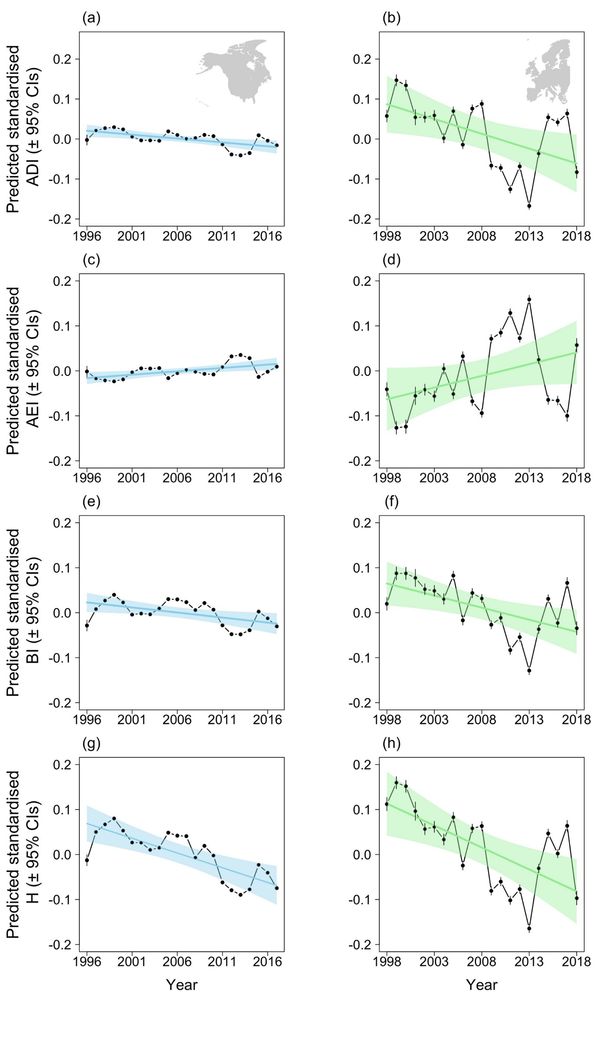
Figure 2 Predicted annual variation in Acoustic Diversity Index, ADI (a,b), Acoustic Evenness Index, AEI (c,d), Bioacoustic Index, BI (e,f) and Acoustic Entropy, H (g,h) in North America (left column) between 1996 and 2017 and in Europe (right column) between 1998 and 2018. Declines in ADI, BI and H and increases in AEI, mean that the soundtrack of our spring has become quieter and less varied.
What is driving changes in soundscapes?
As you may expect, in general, sites that have experienced greater declines in either total abundance and/or species richness also tended to show greater declines in acoustic diversity and intensity, and vice versa (Figure 3). This relationship is shown in Figure 3 for acoustic diversity index (ADI); while you can clearly see the association described above, there are also many sites that don’t fit this general pattern. These inconsistencies suggest that, for any given site, initial community structure and how the call and song characteristics of the resident species complement each other, also play important roles in determining how soundscapes change. Future work is needed to explore these patterns further.
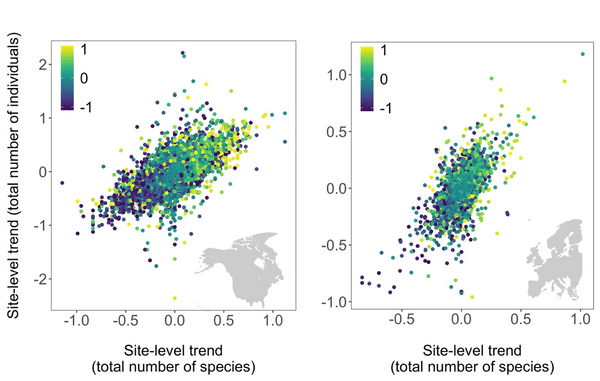
Figure 3 The association between site-level trends in the total number of species and the total number of individuals in 202,737 NA-BBS sites across North America (left column) and in 16,524 PECCBMS sites across Europe (right column). Colours indicate site-level trends in Acoustic Diversity Index, ADI, (yellow – improving soundscape quality; blue – declining soundscape quality). Sites that have experienced great changes in their bird communities tended to have also seen greater changes in the soundscape quality, although this was not always the case.
Why are these findings important?
As we collectively become less aware of our natural surroundings, we also start to notice or care less about their deterioration. A soundscape that is normal to me now would likely seem depauperate to my grandparents’ generation. We have a lot to still learn about how the changes in our natural world affect our society, studies like ours aim to heighten awareness of losses in a tangible, relatable way and highlight their potential impact on human well-being.
Image credit
Top right: Phylloscopus trochilus © Jyrki Salmi CC BY-SA-2.0 Wikimedia Commons.
If you want to write about your research in #theBOUblog, then please see here.


